Motor: circa 1994, Mercruiser 7.4 L (i.e. 454 chevy big block). This applies to nearly any big block Mercruiser.
Problem: Starter mounting bolt is broken off with threaded section left in motor block. Being a boat motor, access is very, very limited to the point where reaching down along the motor and feeling is the only access to the rear of the motor block. And that is just where the starter and the mounting bolt is located. Most internet comments and solutions indicate that the only way to get the broken section out of the motor is to pull the motor and then drill and extract.
Comments: Note that the reason for the bolt breaking off is not really known. After the boat had set up for several weeks, I tried to start it. The starter did not engage – seemed just to simply spin. I assumed that the starter throw-out was damaged and the starter needed to be replaced. I started to unbolt the starter from the boat and found the mounting bolt farthest away from the block was missing. I found it in the bilge, broken off. I removed the other bolt (nearest the block) and removed the starter. The starter appeared to be just fine. I believe that the starter bolt broke, dropped out and then the starter twisted just enough so that it would not engage the flywheel. It is possible that the bolt had been broken for quite a while and that the single remaining mounting bolt was holding the starter near-enough in place to engage the starter.
I do not know why the bolt would have broken in the first place. I do note that the bolt extends about ½ inch into the block before encountering threads, i.e. the shaft acts like a dowel. My best guess is that the bolt was over-torqued and weakened at the transition point between the smooth-shaft dowel portion of the bolt and the threaded end of the bolt. Eventually, this weakened area failed and the bolt fell out.
I’ve also read that in some cases the bolt is too long and then the threads bottom out. The installer continues to tighten in order to get the starter to snug. After a high torque the region at threads-to-shaft is weak and eventually breaks.

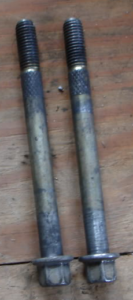
Solution: Pulling the motor from my boat is a major operation requiring a significant hoist (a 454 is heavy) and disconnection of a lot of stuff attached to the motor. Because the motor was broken during peak summer season and getting the boat to a trustworthy shop would be difficult, I decided to research thoroughly for possible removal methods and make a substantial effort to the get the bolt out….without going to a shop and pulling the engine.
The most common recommendation is to simply drill out and use an “easy out” to then twist out the bolt. There is a lot of caution about drilling the hole in the center and taking care not to break off the strong but shatterable easy out. Once the easy-out is broken, getting it out is nearly impossible. Because of the very difficult access to the broken bolt, this was scary.
I also found that often mechanics use a left-handed drill to drill out stuck or broken bolts. The drill will always apply torque in the “out” direction. As it drills, sometimes it releases stress in the bolt, the bolt will simply release, and screw out while being drilled. The mechanics start with a small drill and then move to a larger and larger drill to hollow out the bolt. At the extreme end of the process if the bolt stays stuck, the threads and a little material are all that is left. An easy-out might then be used but usually the bolt has already come out during the drilling process. If it is still stuck, they drill it completely out and put in a repairing helicoil insert.
I decided to try the removal process using a left-handed drill.
But getting a drill back to the bolt is impossible. The floor is inches away. It is back where all I can barely do is reach one hand to feel the bolt. The flywheel cover is right up against the starter and the clearance between the flywheel cover and the bolt hole is only an inch or so.
I need a drill with a 90-degree head without a bulky head.
There are several 90-degree heads available. Some are 1/8 inch drives for placing screws. Some have a flexible shaft with seemingly no real torque ability, i.e. not very good for drilling steel. I found an adapter head for a drill at Home Depot that looked like it was beefy enough to provide drilling torque….but it was bulky and looked like it would but up against the clearance between the flywheel and the bolt.
However, I did find an air-driven (pneumatic) drill that several commentators said they used for drilling in tight spaces. And one even said that they used it to drill out bolts in tight spaces. This sounded good. I bought one and found that the head was indeed much smaller than the drill adapter. Overall, it was a much more compact unit than a cordless or corded drill…if you can maneuver the air hose.
Now examine the drilling situation. Drilling would be blind. There was no way to see where I was drilling and certainly no way to use a punch to make a centered starter dimple for the drill bit. But I also recalled that the bolt had first a dowel section shaft before the threaded section. Because the bolt broke off just above the threads, the broken section was recessed into the block. I looked like this. There was the flat mounting surface for the starter on the motor block. Then about 1/4in long smooth-bore hole for the starter bolt dowel section, and then the beginning of the threads for the bolt. So the drill bit would extend into the hole about 1/4 inch before it encountered the broken bolt.
A #6 washer has about the same outer diameter as the starter bolt shaft and therefore the smooth bore of the hole in the block (#6 washer: 5/32 ID with 3/8 OD). So I used a 5/32 in left handed drill bit with a #6 washer on it. The washer was held on the end the bit via some duct tape. The washer would keep the drill centralized in the smooth bore and the drill could then drill on the bolt. I started with the bit extended not quite ¼ inch above the washer. As I got deeper, the duct tape could simply give while keeping the washer in place centralizing the bit.
I maneuvered this setup – pneumatic 90-deg drill with 5/32 in dia left handed drill topped with duct tape and #6 washer – back to the broken bolt hole. The maneuvering was tight, not anything to spare. The airline was a pain. BUT AFTER DRILLING FOR LESS THAN 30 SECONDS THE BOLT STARTED SCREWING OUT AND FELL OUT ONTO THE FLOOR. That was it. Done. Eureka. $150 and it was out.
Material used:
Bits: $8 left handed drill set from Harbor Freight. I had other (5/32 and ¼ in) Irwin bits in reserve but never used them
Pneumatic 90-deg head drill: Ingersoll-Rand IR7807R (Amazon $90). The one at Harbor Freight may be similar. But this IR is really, really nice.
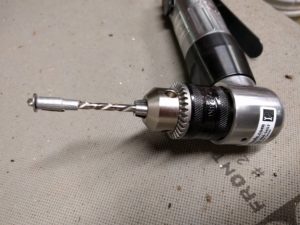
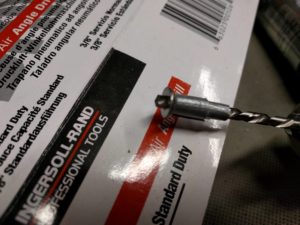
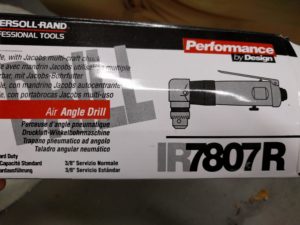
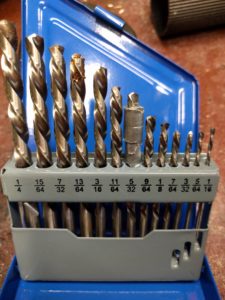
From the internet…
Interesting thread…see post #7 http://www.marineengine.com/boat-forum/showthread.php?410788-Broken-starter-bolt
And sketch of starter motor and bolt: http://www.marineengine.com/boat-forum/attachment.php?attachmentid=7373&d=1375440885
Fear problems…but the left-handed drill worked just fine: https://forums.iboats.com/forum/engine-repair-and-maintenance/mercruiser-i-o-inboard-engines-outdrives/402657-how-to-extract-a-broken-starter-bolt-from-the-block-without-removing-the-engine
